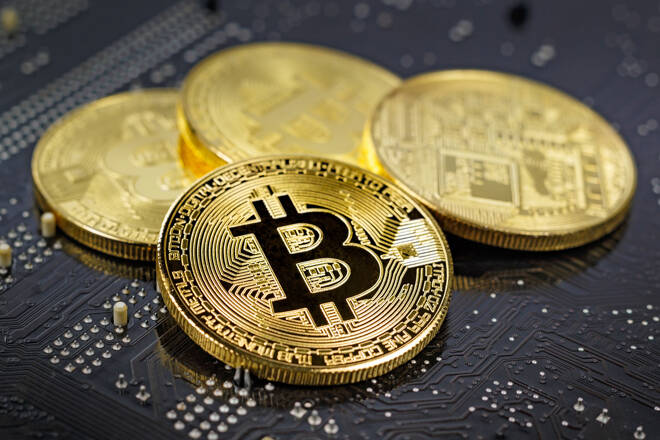Advertisement
Advertisement
Bitcoin’s Hybridization With The U.S. Dollar, The Buck Stops Here
Published: Mar 30, 2021, 01:17 GMT+00:00
The world’s two largest digital currencies both had substantial gains over the weekend.
Their rise continued into today as Visa announced in a statement stating, “Visa’s standard settlement process requires partners to settle in a traditional fiat currency, which can add cost and complexity for businesses built with digital currencies. The ability to settle in USDC can ultimately help Crypto.com, and other crypto native companies evaluate fundamentally new business models without the need for traditional fiat in their treasury and settlement workflows. Visa’s treasury upgrades and integration with Anchorage also strengthen Visa’s ability to directly support new central bank digital currency (CBDC) as they emerge in the future”.
This new method for swiftly exchanging and spending cryptos without exchanging them into fiat currencies through a third-party exchange is a new development for the cyrpto.com card or any credit card, for that matter. However, the technology behind USDC and other stable coins such as “Tether” (the most widely used stable coin, created in 2014) this widespread adoption and true integration is something of a recent development. Stable coins have helped people in making cross-border transactions both quicker and cheaper without the volatility associated with other cryptocurrencies. This is due to the fact that they are pegged to a fiat currency, almost always being the U.S. dollar.
In fact, taking a quick glance at coinmarketcap.com, one can easily see how Tether has been utilized as a means for sending or receiving funds more than Bitcoin and Ethereum combined. Today, for example, tethers volume in the last 24 hours was over $80 billion and has for the past few years held the title of the most widely used way to transfer funds via blockchain.
Tether is supposed to be backed by cash reserves or reserved assets, although there has been some mistrust dealing with how much reserves they actually have on hand. USDC has overcome these concerns by having complete transparency — and giving users the assurance that they will be able to withdraw 1 USDC and receive $1 in return without any issues. To this end, it says a major accounting firm is tasked with verifying the levels of cash that are held in reserve and ensuring this matches up with the number of tokens in circulation. Although the volume in this stable coin is currently 80 times smaller than that of Tether, which has been in circulation for over six years, it offers so obvious advantages, and the three-year-old USDC will surely grow at a quick pace, especially with these new developments.
Bitcoin rose about steadily over the weekend, and the additional 3% earned today puts BTC futures at approximately $58,000, forming a sizable gap between today’s candle and Friday’s. At the same time, Ethereum gained a full 8% today alone. This is likely due largely to the fact that while Tether has been programmed to run on several blockchains, USDC is running exclusively through the Ethereum blockchain. Another aspect of stable coins that I think is being overlooked by other market technicians is their effect on the U.S. dollar. Not only does their increased usage reaffirm the dollar as the world’s reserve currency, but their spike in the digital currency world benefits the dollar directly instead of going against it as cryptocurrencies innately do. They are considering the fact that the more stable coins are used and in circulation directly equates to more purchasing of U.S. dollars and U.S. treasury bonds in the case of USDC.
To illustrate this point, consider the following circumstances of the U.S. dollar index. After a rough four months of declining value in the U.S. dollar, in which time the index lost a whopping 11% in value. Now consider that a month ago, we had a reversal in the USD, a pivot from bearish to bullish. Now consider it was exactly one month ago when Visa announced they were going to soon be implementing the use of USD coin on their crypto.com card. Since then, the dollar has seen one golden cross between the 50- and 100-day moving averages and a stellar 3% increase in value drastically different than the months prior. I cannot claim this is entirely due to USDC, but I will put my neck on the line to suggest that it had a huge part in the dollar’s sudden reversal from bearish to bullish.
This is a narrative where people have wanted to take part in the many benefits of Blockchain and decentralized ledgers but were stuck on the fact that digital currencies are not backed by any guarantee and are wildly volatile. These problems have had been remedied many years ago by the introduction of stable coins. In essence, these coins bridge the gap between fiat and crypto while at the same time guarantying value and minimizing their volatility. This topic is one that I will dive into in the future, most assuredly probably do that myself. All my editing show is your show part of it.
About the Author
Joseph M. Wagner IIcontributor
Joseph m. Wagner II has been studying technical analysis for eight years. He is a producer and video editor at thegoldforecast.com. His primary focus has recently been bitcoin and cryptocurrencies. He writes a daily blog for the gold forecast titled “Bbitcoin Fundamentals.”
Advertisement
